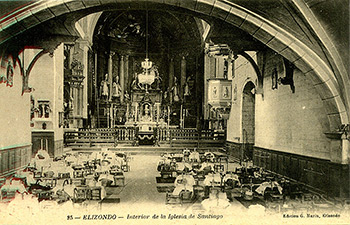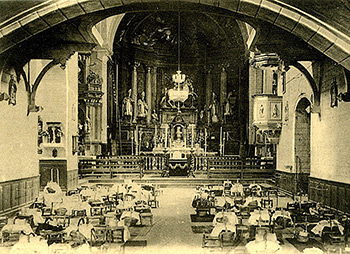Route through the 18th century altarpieces of Baztania
Elizondo: two retablos in the space of thirteen years, both disappeared
Two altarpieces were immediately affected by the classic model of Irurita, in the towns of Elizondo and Arraioz. In the first case, and a few years after the construction of an altarpiece, it was decided to replace it. The Elizondo altarpiece was commissioned in 1762 to Silvestre Soria, the great master of the Rococo period in Navarre, trained in the workshop of the royal or new palace in Madrid with Juan Domingo Olivieri. The promoter of the work was in this case a man from Baztan, Ambrosio Agustín de Garro, knight of the Order of Santiago, who was established in the Court of Madrid as treasurer of the Infante Don Luis Antonio Jaime. Before signing the notarial deed of commitment, the promoter obtained the corresponding permission of the place, council and its vicar, and commissioned a design and conditioned to the prestigious Silvestre de Soria, master sculptor based in Pamplona. Precisely with his own traces he undertook to make the altarpiece, with small modifications that are carefully noted in the commitment. Among them are those of making the first body decrease a little to give more space to the second; providing greater relief to the moldings and trophy of the main arch; slightly decreasing the size of the sculptures of St. Peter and St. Paul; and download of ornament the flying buttresses that were behind the figures, also eliminating the trophies of war and suppressing decoration of the tabernacle to give the impression of greater grandeur. Soria's obligation would be to commission the sculpture and gild and marbleize the entire altarpiece, "foreseeing that it must have a little more gold than the altarpieces of the church of Azpilkueta". Pine wood was once again chosen as the material for the entire set. The price was agreed at 2,360 pesos of 128 quarters, to be paid as the work progressed, and the deadline was set for St. John's Day, 1763.
A few years later and for reasons that can only be aesthetic and fashionable, between 1775 and 1777 a new altarpiece was made for the parish of Elizondo to replace the one of 1762 and under the patronage of the same family. In this case it was due to a testamentary disposition of Ambrosio Agustín de Garro, which would be fulfilled by his son and testamentary Don Nicolás Ambrosio de Garro. Both were treasurers of the infante don Luis Antonio. The will of the aforementioned Ambrosio Agustín included the sum of 52,000 reales de vellón for the "renovation of the main altarpiece of Elizondo". With this amount, José Poudez, an architect and sculptor from Pau, was made position of the new altarpiece. Poudez was a French master active in several projects in the valley and in the collegiate church of Roncesvalles/Orreaga, who was paid different amounts for the new altarpiece in Elizondo between 1775 and 1777. The polychromy of the set was subcontracted by Poudez to the Pamplona gilder Juan Francisco Santesteban in June 1776, when it was already finished, stating that the gold should be the best from Pamplona or Paris. The sculptures that figured in the altarpiece are, besides Santiago on horseback with the Moors in the lower part, those of the saints Ambrosio, Agustín, Nicolás and Fermín. The altarpiece disappeared a century ago when the new parish of Elizondo was built (1916-1925). A postcard-sized photograph shows its classicist lines, in harmony with what was done in Irurita.
CRUZ YABAR, M. T., "José de Hermosilla y el retablo de Irurita en Navarra", file Español de Arte, n.º 290 (2000), pp. 51-65.
FERNÁNDEZ GRACIA, R., El retablo barroco en Navarra, Pamplona, Government of Navarre, 2003.
FERNÁNDEZ GRACIA, R., "El triunfo del Academicismo en los retablos baztaneses y el project para el mayor de Villafranca (1783) en un dibujo de la Library Services Nacional", Studium, Magisterium et amicitia. Homage to professor Agustín González Enciso (ed. R. Torres Sánchez), Pamplona, Eunate, 2018, pp. 467-478.
FERNÁNDEZ GRACIA, R., "En torno a la registration de la Virgen del Rosario de Irurita, obra de Juan Domingo Olivieri, de 1749", Pieza del mes de marzo de 2023. Chair de Patrimonio y Arte Navarro.
GARCÍA GAINZA, M.ª C., "Virgen del Rosario, signed by Olivieri", file Español de Arte, n.º 235 (1986), pp. 324-329.
GARCÍA GAINZA, M.ª C., El escultor Luis Salvador Carmona, Pamplona, University of Navarra, 1990.
GARCÍA GAINZA, M.ª C., "Sobre las esculturas de Luis Salvador Carmona en Lekaroz", Cuadernos de la Chair de Patrimonio y Arte Navarro, n.º 2, Pamplona, 2008, pp. 243-255.
GARCÍA GAÍNZA, M.ª C., "Alonso Cano y José Ribera, fuentes inspiradoras en la obra de Luis Salvador Carmona: el martirio de san Bartolomé de Lekaroz", Pieza del mes de mayo de 2015. Chair de Patrimonio y arte navarro.
MARTÍN GONZÁLEZ, J. J., "Problemática del retablo bajo Carlos III", Fragmentos n.º 12-14 (1988), pp. 33-43.










